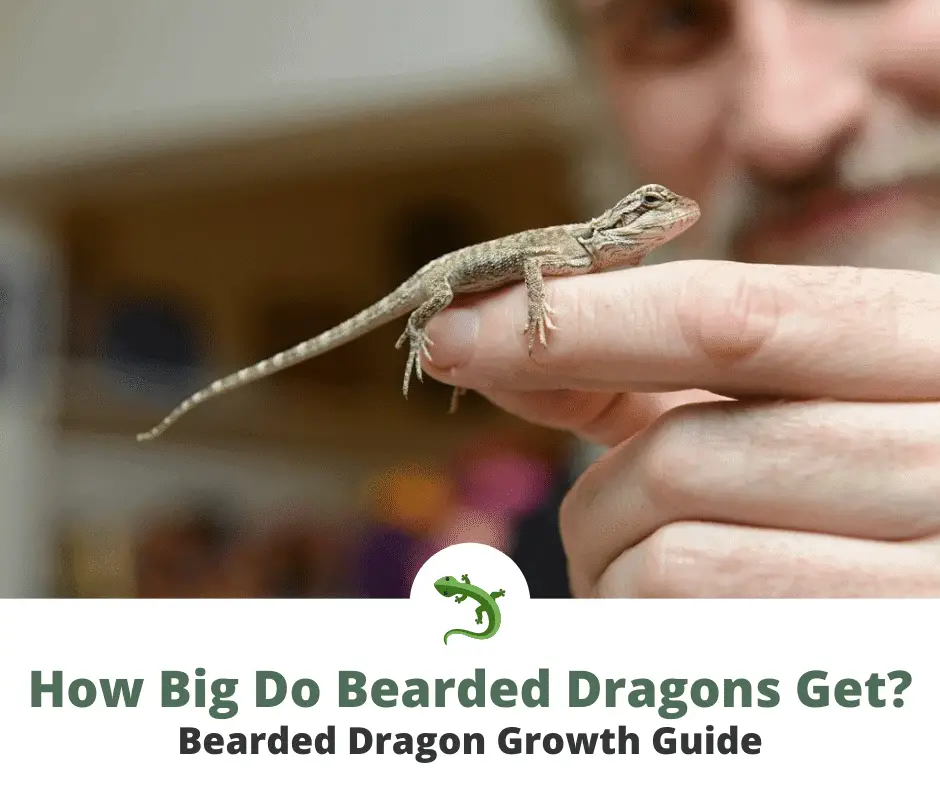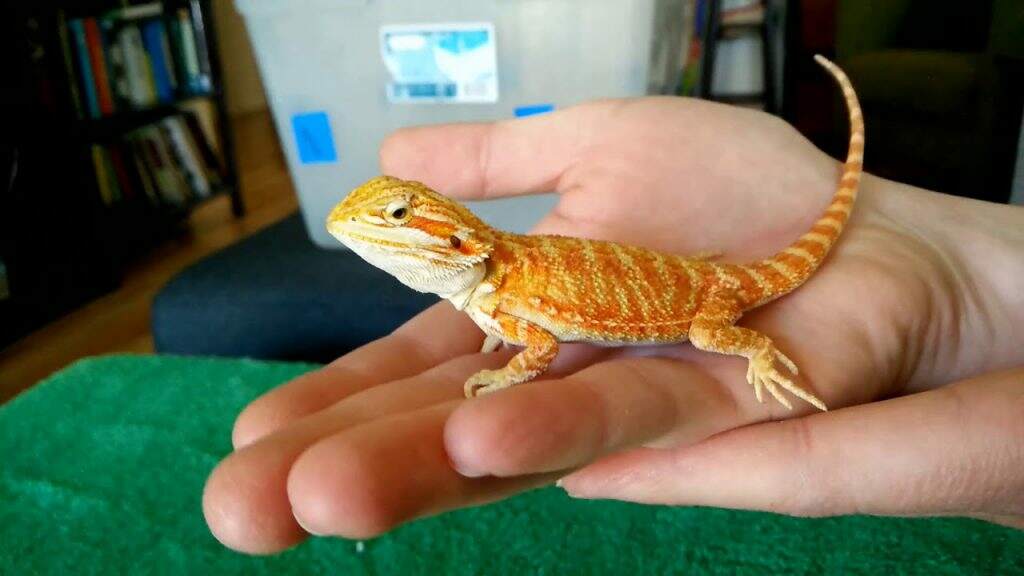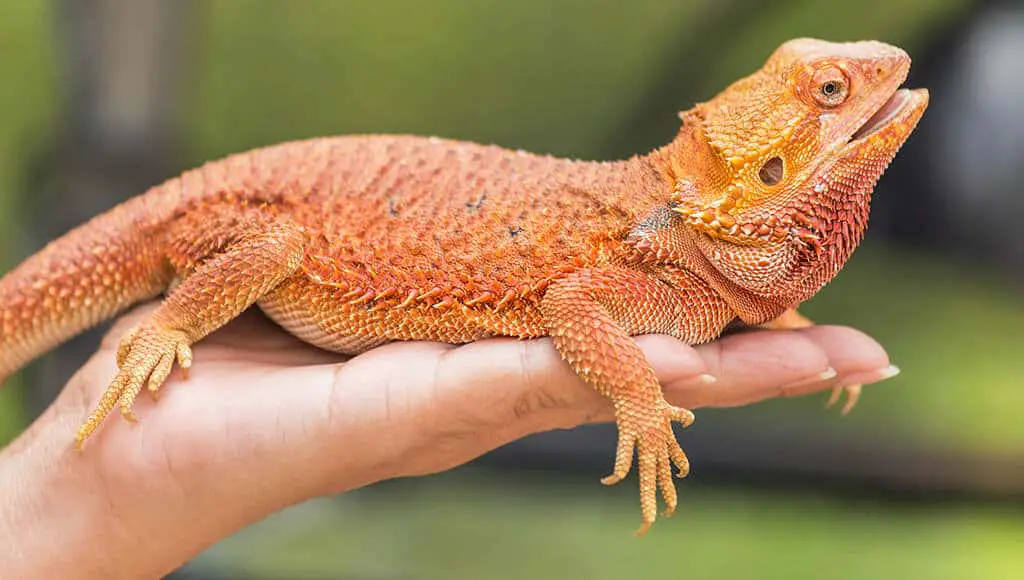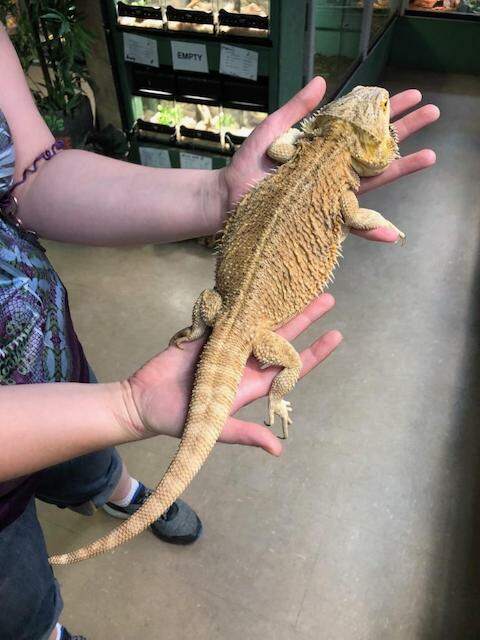This guide will teach you how big bearded dragons can get in captivity. If you’re considering one as a pet, it’s important to know what to expect.
In this guide, you’ll learn:
- How big do Bearded Dragons get when fully grown?
- How fast do Bearded Dragons Grow?
- What influences their size?
- How heavy do they get?

If you’re planning to get a Beardie as a pet, knowing how big they grow will help you prepare for many things like tank size, environment, diet, and general health.
This article will help you understand the different factors that affect a Beardie’s size to help you give the best care to these beautiful, docile reptiles, which are often considered great, relatively low-maintenance pets.
How Big Is A Fully Grown Bearded Dragon?
Fully grown bearded dragon ranges from 1 to 2 feet in length and weighs up to 1 pound.
During Stage 1 Growth, they can grow 1-3 inches weekly. At Stage 2 Growth, their growth slows to 1-3 inches per month. Once sexual maturity is reached, growth in length stops, and the only changes will be in your Beardie’s weight.
Bearded Dragon Growth Stages
Stage 1 Growth | Baby Bearded Dragon Size
Baby bearded dragons, sometimes referred to as hatchlings, grow up to 9 (sometimes 11) inches until they are 2 months old where they can weigh up to 1.23 ounces.
At this rapid growth stage, they can grow as fast as 1-3 inches per week and require frequent feeding. A baby bearded dragon’s diet will need to consist of 70-80% live insects and 20-30% leafy greens and veggies.

Stage 2 Growth | Juvenile Bearded Dragon Size
At about 2-7 months of age, bearded dragons are considered juveniles, a point wherein they can reach up to 18 inches in length and weigh up to 9.88 ounces. Juveniles can grow 1-3 inches per month and gain up to 1.76 ounces.

Stage 3 Growth | Adult Bearded Dragon Size
In general, adults can grow up to 24 inches from head to tail but are usually within the range of 18-22 inches when fully grown, weighing from 13-18 ounces.
Adults are fully grown once they reach sexual maturity, the exact time of which differs for each lizard, ranging from 8-18 months of age. The bearded dragon growth chart below will help you track how much your Beardie will grow at a certain age.

Bearded Dragon Growth Chart
| Age in months | Length in inches (measured from head to tail) | Weight in ounces |
| 0-1 months | 3-4 inches | 0.14-0.25 ounces |
| 2 months | 5-9 inches | 0.28-1.41 ounces |
| 3 months | 8-11 inches | 0.77-3.88 ounces |
| 4 months | 9-12 inches | 1.45-4.05 ounces |
| 5 months | 11-16 inches | 3.60-4.06 ounces |
| 6 months | 11-18 inches | 6.46-6.63 ounces |
| 7 months | 13-18 inches | 8.11-9.88 ounces |
| 8 months | 14-20 inches | 8.89-11.5 ounces |
| 9-10 months | 16-22 inches | 9.88-12.7 ounces |
| 11-12 months | 22-24 inches | 12.3-16.5 ounces |
Tracking growth is easy and will help you check for any health problems; all you need is a measuring tape, a medium-sized kitchen scale, and a bowl you can put your Beardie in.
As babies, you will have to track the growth of your Beardie to make sure they are healthy and within the normal growth rate. If you track how fast your bearded dragon grows as a juvenile, you can get a sense of how big they’ll be as adults which can help you prepare the right tank setup for your bearded dragon.
If they are about 15 inches at 6 months, then your Beardie is on the big side and can be expected to grow up to 22 inches. However, this is not a hard and fast rule since bearded dragon growth is affected by other factors such as diet, health, and environment. Make sure you provide the best care for your bearded dragon so they live up to their names!
How Fast Do Bearded Dragons Grow?
Bearded dragons tend to grow quickly within 2-3 months as babies, reach up to 11 inches long, and gain up to 1.23 ounces. After that, the growth rate slows down to 1-2 inches, gaining 1.76 ounces per month during their first year as juveniles. From there, they can grow another inch or two in their second year as adults.
How long does it take for a Bearded Dragon to grow to full size?
It takes 8-18 months for bearded dragons to reach sexual maturity and become fully grown. Full size bearded dragons can range from 22-24 inches in length.
When do Bearded Dragons stop growing?
Bearded dragons typically stop growing at about 11-12 months old but some can still grow until they are 18 months or even 2 years old! Senior bearded dragons may still grow but usually they just bulk up instead of growing in length.
Different Species of Bearded Dragon (Pogona) and Their Sizes
Bearded dragons belong to the Pogona genus consisting of 8 different species, all originating from Australia which is their natural habitat. Pogona vitticeps or the Central bearded dragon are the most common species you’ll find as pets. Below is information on the maximum length of a bearded dragon based on their species.
- Pogona vitticeps; Central Bearded Dragon (24 inches)
- Pogona barbata; Eastern Bearded Dragon or Coastal Bearded Dragon (24 inches)
- Pogona minor mitchelli; Mitchelli Bearded Dragon (18 inches)
- Pogona minor minor; Dwarf Bearded Dragon (14-18 inches)
- Pogona nullarbor; Nullarbor Bearded Dragon (14 inches) (sometimes misspelled as Pogona nullabor)
- Pogona minor minima; Western Bearded Dragon (12 inches)
- Pogona henrylawsoni; Lawson’s Bearded Dragon; Rankin’s Dragon (12 inches)
- Pogona microlepidota; Drysdale River Bearded Dragon (4-6 inches)
You may come across the term “morphs,” which is similar to a dog’s breed where genetics and breeding play a role in teasing out certain favorable traits such as the German Giant Morph bearded dragons who grow up to 32 inches in size. Morphs are not considered as different species of bearded dragons.
📚 Read More >> Silkback Bearded Dragons
What Factors Influence A Bearded Dragon’s Size?
Aside from age and species, there are other factors that affect the growth of bearded dragons, all of which you should consider for your Beardie to have healthy growth and reach their optimal size.
Genetics
As with most reptiles that have been bred in captivity, certain traits and genetic mutations such as those pertaining to color, scales, and spikes are brought out on purpose through breeding. In rare cases when your Beardie is a German Giant morph, it can grow up to 32 inches long and weigh up to 35 ounces.
Bearded dragons have numerous known morphs or genetic mutations so you should read up on this thoroughly since certain morphs may need special care. Having said that, it is also very important that you get your Beardie from a reputable breeder so you are sure that the bearded dragons are bred responsibly and are not prone to sickness.
Gender
Gender, in general, is a factor that does affect a Beardie’s size – males are often longer in length than females. Though males tend to be generally larger than females, some females can be larger than males. Males have larger and wider heads compared to females. Females have bodies that are a bit broader than males with a slimmer and more slender tail. Males are usually longer with a broader or thicker tail base.
Gender Identification
There are several ways to determine if your bearded dragon is male or female without taking them to the vet for an x-ray such as checking their underside for bumps.
You may hear about some behavioral traits that are gender specific such as male bearded dragons turning their beards black or females waving their arms and digging to hide their eggs but these aren’t always accurate. All bearded dragons, male or female, have the ability to turn their beards black when threatened or under stress. It just so happens that males, being more territorial, do this more often.
📚 Read More >> Caring For Bearded Dragon Eggs
The most accurate way to check your Beardie’s gender is to look at the “hemipenal bulges” or bumps underneath their tail, near the vent. You can do this by gently lifting the tail up or shining a flashlight through it. Males will have two bumps running parallel to the tail while females will have one bump running across the tail near the vent. This method is only 100% accurate for Beardies that are 2-3 months old.
Diet
Bearded dragons need the proper diet during each growth period. In general, Baby bearded dragons (1-3 months old) will require protein rich food like insects to aid in their rapid growth phase. Vegetables (most greens, carrots, sweet potatoes) are then slowly added to their diet as they grow older.
Baby Beardies that do not get enough protein may end up having stunted growth and other health issues. Older bearded dragons will need more variety in their diet to ward off digestion problems. Bearded dragons also like fruit but these should be given in moderation (10% of their diet).
Proper nutrition and a well-balanced diet for your Beardie will make sure it grows well and help it fight diseases. Make sure your insects are bought from a reputable breeder to avoid any toxins or insecticides.
Supplements such as calcium and vitamin D3 are also essential for bearded dragons for bone development and for proper nutrition of pregnant females.
Housing: What Tank Size Should a Full Grown Bearded Dragon Have?
The general housing rule for ideal growth and health is: bigger is better.
Fully grown Beardies will require at least 55 gallons but the recommended size is between 75-120+ gallon tanks with a dimension leaning towards wider (for more room to move) and taller (for better temperature regulation and climbing). A good tank dimension would be 48” x 18” x 21”. Bigger enclosures allow for more hiding places, room to roam, and are closer to their natural habitat.
Younger bearded dragons can stay in smaller tanks but as they grow, you should transfer them to bigger tanks. Bearded dragons by nature, will control their growth according to their surroundings, so smaller tanks will lead to smaller dragons.
How Much Do Bearded Dragons Weigh?
Health and growth of lizards and reptiles always go hand in hand so you should always keep an eye on the ideal weight of your Beardie and observe if it becomes under- or overweight.
Is My Bearded Dragon Is Overweight?
If your bearded dragon looks a bit stout and round when you look at it from above, has fat limbs, and a full chest then it may be overweight. In the wild, lizards and reptiles have to hunt for their prey so they don’t always have a constant source of food. They are not naturally equipped to handle being overweight so this can lead to health problems such as fatty liver disease.
Lowering the tank temperature (heat prompts them to eat), providing the proper diet (less live food with high fat and protein), and even some exercise such as walking your Beardie will help with weight issues.
Is My Bearded Dragon Is Underweight?
On the other hand, a bearded dragon with sullen, wrinkly, and sagging skin that hangs from their body and sunken fat pads at the back of their heads is probably underweight. Their ribs and spine may also be protruding from their body.
Pay close attention to their weight during the growth phase (first 2-3 months) because being underweight at this stage may point to nutrition problems, an illness, or early brumation (hibernation) that can lead to stunted growth and other complications.
The most common cause of loss of appetite in bearded dragons is temperature (colder temperatures slow down their metabolism) but it can also be the quality of their food. Give them a high fat diet, an appetite stimulant, or a feed supplement to help it gain weight.
The growth table above can also serve as a guide for watching your Beardie’s weight.
Conclusion
“How Big Do Bearded Dragons Get?” may seem like a simple question out of curiosity but to a future bearded dragon parent, it opens up important points that will help them give the best care possible. From ensuring healthy growth with the proper diet and nutrition to providing the correct tank so that your bearded dragon will reach its maximum size, allowing them to become dragons in their own right.
FAQs
How big do female Bearded Dragons get?
Fully grown female bearded dragons will be from 16-19 inches long with broader bodies and a more slender tail.
How big do male Bearded Dragons get?
Male bearded dragons, once fully grown, will be about 21-24 inches long with wider heads and a thicker tail base.
Further Reading
Introduction to bearded dragons:
Bearded dragons: facts and photos
Bearded Dragon – Pogona
An exhaustive guide to bearded dragons from taxonomy, history, behavior, breeding, and many more:
Husbandry Manual For Bearded Dragons. Reptilia: Agamidae
Quick guide to the essential needs of a bearded dragon:
Bearded Dragon Husbandry and Preventative Healthcare
A comprehensive guide on bearded dragon care:
Bearded Dragon Care Guide | Long Island Avian and Exotic Vet Clinic
Explaining common myths and facts about bearded dragon care:
Myths and Facts about Bearded Dragon Care


